This seminar by José Dias, he shared insights from his practice in jazz performance and ethnography. He observed that artistic research can feel too personal, or conversely like social work. But how to generalise? We need contexts for meaning. Generalising means, ideally, making the research relevant to us all
Inquiry, he said, is a way of questioning the world. Qualitative research can validate your practice, give it structure/framing, and allows you to communicate in different ways.
‘Quality’ in qualitative research is not, therefore, meant in a hierarchical sense. He discussed specific methods he uses, such as discourse analysis, and dialogic ethnography, which studies cultural, emotional, social meanings. Socially, these are negotiating meanings
Autoethnography, on the other hand is about, ‘Why is this important to me?’
Why Does This Matter for PhD students?
The PhD, by definition, is an original contribution to universal academic knowledge. In artistic practice, this includes:
• Creative process as inquiry
• Artworks as research outcomes
• Contextual, reflective, and critical analysis
Qualitative research provides a language to frame and validate practice, and tools to investigate, question, and communicate meaning. In artistic practice, it is an approach to knowledge through:
• Subjective, contextual, lived experience
• Critical reflection on process
• Exploration of cultural, emotional, social meaning
It combines making, thinking, writing, reflecting.
Key Characteristics are an emphasis on:
• Exploration over measurement
• Process over product
• Meaning over proof
It supports deep engagement with materials, contexts, and concepts.
Common Qualitative Methods:
• Autoethnography (your story as data)
• Interviews / dialogic ethnography (collaboration & context)
• Fieldwork & observation (immersive research)
• Documentation (notes, sketches, process videos)
• Embodied inquiry (movement, sound, gesture)
These methods are not separate from practice—they are often embedded in it.
Practice-Based vs. Practice-Led research:
• Practice-Based:
- The artwork is the contribution to knowledge
- Supported by critical reflection
• Practice-Led:
- The research leads to insights that inform or are informed by practice
- Art is a method, not just an outcome
It all must, he said, start with a research question. This can (should) emerge from your practice. It must present a new angle into your ongoing research, and should go beyond your personal inner exploration.
What Are You Really Investigating?
• What questions do I return to in my practice?
• What am I trying to understand through making?
• How does my work speak to broader cultural, philosophical, or political issues?
Outcomes in Artistic Research
• Artworks (installations, performances, scores, etc.)
• Documentation (photos, videos, rehearsal logs)
• Reflections (studio journals, essays, exegesis)
• Contextual writing (thesis, conference papers)
Aligning Artistic Research with the Frascati Manual
The OECD Frascati Manual defines research as:
“Creative and systematic work undertaken to increase the stock of knowledge…”
Artistic research can align with this by ensuring:
– Originality: the project makes a novel contribution to knowledge
– Creativity: artistic methods are valid forms of inquiry
– Systematic Approach: clear research questions and methods
– Transparency: documented processes and reflection
– Transferability: insights extend beyond the artwork itself
Include a written component explaining the research context
Frame your practice as a rigorous, knowledge-producing process
Five Concepts of Artistic Research (Gerard VILAR 2018)
A controversial tendency is now clear: the blurring of differences between art and sciences, arguing that art is a path to knowledge production that is equally as legitimate as the traditional sciences. But is that a good strategy in the skirmishes to gain more legitimacy in the space of academic institutions of higher education and get access to funding? And, is it true that artistic research is comparable to or homologous with scientific research in the field of experimental, social or human sciences and that herein lays the cognitive value of art? Is “artistic research” a sign of submission to the new cognitive capitalism? (Moulier-Butang, 2012).
Five Concepts of Artistic Research (Gerard VILAR 2018)
• Research and production
• The artist as a social researcher
• Curator as researcher
• Research as Disturbances of Reason
• Research as exploration of the Great Outside
Resources
Knowles, J. G., and Ardra L. Cole, Handbook of the Arts in Qualitative Research: Perspectives, Methodologies, Examples, and Issues. Thousand Oaks, CA: SAGE Publications, Inc., 2008. https://doi.org/10.4135/9781452226545
Biggs, Michael and Henrik Karlsson. The Routledge Companion to Research in the Arts. (2010)
Marsh, Julie. “Site-integrity: An embedded and embodied approach to practice-based research.” Scene (2023)
Vilar, Gerard. “Does Artistic Research Produce Knowledge? A Five-Fold Distinction.” (2018)
